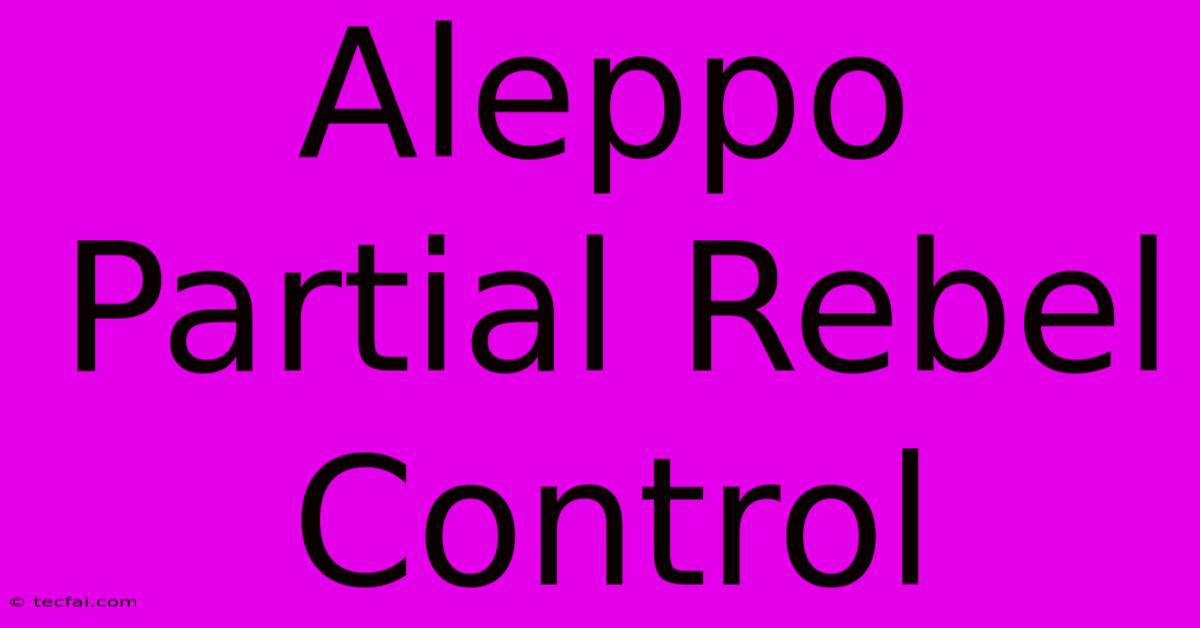Aleppo Partial Rebel Control

Discover more detailed and exciting information on our website. Click the link below to start your adventure: Visit Best Website tecfai.com. Don't miss out!
Table of Contents
Aleppo Partial Rebel Control: A Complex History of Conflict and Shifting Power
Aleppo, once Syria's largest city and a vibrant hub of commerce and culture, became a brutal battleground during the Syrian Civil War. Understanding the period of partial rebel control requires examining the complex and evolving dynamics of the conflict, the shifting allegiances, and the devastating consequences for the city's inhabitants. This period wasn't a static state but rather a fluctuating struggle for dominance, marked by intense fighting and territorial gains and losses.
The Rise of Rebel Control in Eastern Aleppo
The Syrian Civil War, which began in 2011, saw Aleppo gradually become a key strategic location. Initially, protests against the Assad regime were met with violent crackdowns. As the conflict escalated, armed rebel groups, a diverse coalition of factions with varying ideologies and levels of organization, gained a foothold in the city. By 2012, significant parts of eastern Aleppo fell under rebel control, while the regime maintained a grip on the western side. This division created a de facto split city, a stark physical representation of the broader conflict.
This partial rebel control wasn't uniform. Different rebel groups, including the Free Syrian Army (FSA) and various Islamist factions, vied for power and territory within the eastern districts. This internal competition often overshadowed the fight against the regime, weakening their overall effectiveness and creating instability within the areas they controlled. The lack of a unified command structure further hampered their ability to effectively govern or provide essential services to the civilian population.
The Siege and the Regime's Recapture
The period of partial rebel control was punctuated by repeated battles and sieges. The Syrian government, backed by its allies – notably Russia, Iran, and Hezbollah – employed a strategy of siege warfare, aiming to starve and weaken rebel-held areas. This strategy proved devastatingly effective, particularly as the regime tightened its control over supply routes into eastern Aleppo.
The turning point came in late 2016, with a major government offensive backed by intense air strikes and ground assaults. After months of relentless fighting and immense human suffering, the regime forces managed to recapture almost all of eastern Aleppo in December 2016. This marked the end of the period of significant rebel control in the city, though smaller skirmishes and pockets of resistance continued elsewhere in the country.
The Human Cost of Partial Rebel Control
The period of partial rebel control in Aleppo was catastrophic for the city's civilian population. Caught between warring factions, civilians faced relentless bombardment, food shortages, lack of medical care, and displacement. The indiscriminate nature of the fighting led to immense casualties and widespread destruction of infrastructure. The experience left a deep scar on the city and its people, with the long-term consequences of the conflict still being felt today. This period serves as a stark reminder of the devastating human cost of protracted civil wars and the complexities of armed conflict in urban environments.
Long-Term Implications and Ongoing Challenges
The aftermath of the battle for Aleppo has had lasting repercussions. The city's infrastructure remains significantly damaged, and rebuilding efforts face considerable challenges. The displacement of millions of people and the deep social divisions created by the conflict continue to impact the lives of Aleppo's residents. The experience serves as a case study in the complexities of urban warfare, the challenges of humanitarian intervention, and the long road to recovery and reconciliation in the aftermath of conflict. Analyzing this period of partial rebel control is crucial to understanding the broader Syrian Civil War and its devastating impact on one of the world's oldest continuously inhabited cities.

Thank you for visiting our website wich cover about Aleppo Partial Rebel Control. We hope the information provided has been useful to you. Feel free to contact us if you have any questions or need further assistance. See you next time and dont miss to bookmark.
Featured Posts
-
Hailee Josh Confirmed Engagement
Nov 30, 2024
-
Auckland Fc Vs Newcastle Jets A League Report
Nov 30, 2024
-
Watch Ole Miss Vs Mississippi State Free
Nov 30, 2024
-
Robust Growth In Global Car Rental Market
Nov 30, 2024
-
1 8 M Tax Bill For Rupert Grint
Nov 30, 2024
